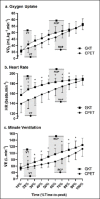Maximal and Submaximal Cardiorespiratory Responses to a Novel Graded Karate Test
- PMID: 34211324
- PMCID: PMC8219271
- DOI: 10.52082/jssm.2021.310
Maximal and Submaximal Cardiorespiratory Responses to a Novel Graded Karate Test
Abstract
The present study aimed to propose and assess the physiological responses of a novel graded karate test. Ten male national-level karate athletes (age 26 ± 5 yrs; body mass 69.5 ± 11.6 kg; height 1.70 ± 0.09 m) performed two exercise tests (separated by 2-7 days): 1) a running-based cardiopulmonary exercise test; 2) a graded karate test. The cardiopulmonary exercise test was comprised of an individualized ramp protocol for treadmill running, and the graded karate test was comprised of a sequence of 'kisami-gyaku-zuki" punching at a fixed frequency of a stationary target that becomes progressively distant. Cardiorespiratory responses, blood lactate concentration, and perceived exertion were measured. A verification phase was also performed in both tests to confirm the maximal physiological outcomes. The graded karate test evoked similar maximal responses to the running protocol: V̇O2 (57.4 ± 5.1 vs 58.3 ± 3.5 mL·kg-1·min-1; p = 0.53), heart rate (192 ± 6 vs 193 ± 10]beats.min-1; p = 0.62) and blood lactate (14.6 ± 3.4 vs 13.1 ± 3.0 mmol·L-1; p = 0.14) with a shorter duration (351 ± 71 vs 640 ± 9 s; p < 0.001). Additionally, the graded karate test evoked higher V̇O2 (72.6 ± 6.5 vs 64.4 ± 4.3 %V̇O2MAX; p = 0.005) and heart rate (89.4 ± 4.6 vs 77.3 ± 7.2 %HRMAX p < 0.001) at the ventilatory threshold and a higher heart rate (97.0 ± 2.4 vs 92.9 ± 2.2 %HRMAX; p = 0.02) at the respiratory compensation point. Incremental and verification phases evoked similar responses in V̇O2 and minute-ventilation during both tests. This novel displacement-based sport-specific test evoked similar maximal and higher submaximal responses, indicating a superior pathway to assess karate athletes.
Keywords: Oxygen uptake; blood lactate; heart rate; martial arts; ventilatory thresholds.
© Journal of Sports Science and Medicine.
Figures



References
-
- Araujo M. P., Nóbrega A. C. L., Espinosa G., Hausen M. R., Castro R. R. T., Soares P. P., Gurgel J. L. (2017) Proposal of a New Specific Cardiopulmonary Exercise Test for Taekwondo Athletes. Journal of Strength and Conditioning Research 31, 1525-1535. https://doi.org/10.1519/JSC.0000000000001312 10.1519/JSC.0000000000001312 - DOI - PubMed
-
- Beaver W. L., Wasserman K., Whipp B. J. (1986) A new method for detecting anaerobic threshold by gas exchange. Journal of Applied Physiology 60, 2020-2027. https://doi.org/10.1152/jappl.1986.60.6.2020 10.1152/jappl.1986.60.6.2020 - DOI - PubMed
-
- Beneke R., Beyer T., Jachner C., Erasmus J., Hütler M. (2004) Energetics of karate kumite. European Journal of Applied Physiology 92, 518-523. https://doi.org/10.1007/s00421-004-1073-x 10.1007/s00421-004-1073-x - DOI - PubMed
-
- Chaabène H., Franchini E., Miarka B., Selmi M. A., Mkaouer B., Chamari K. (2014) Time-motion analysis and physiological responses to karate official combat sessions: is there a difference between winners and defeated karatekas? International Journal of Sports Physiology and Performance 9, 302-308. https://doi.org/10.1123/ijspp.2012-0353 10.1123/ijspp.2012-0353 - DOI - PubMed
-
- Chaabène H., Franchini E., Sterkowicz S., Tabben M., Hachana Y., Chamari K. (2015) Physiological responses to karate specific activities, Science and Sports. Elsevier Masson SAS 30, 179-187. https://doi.org/10.1016/j.scispo.2015.03.002 10.1016/j.scispo.2015.03.002 - DOI
Publication types
MeSH terms
Substances
LinkOut - more resources
Full Text Sources
Miscellaneous
